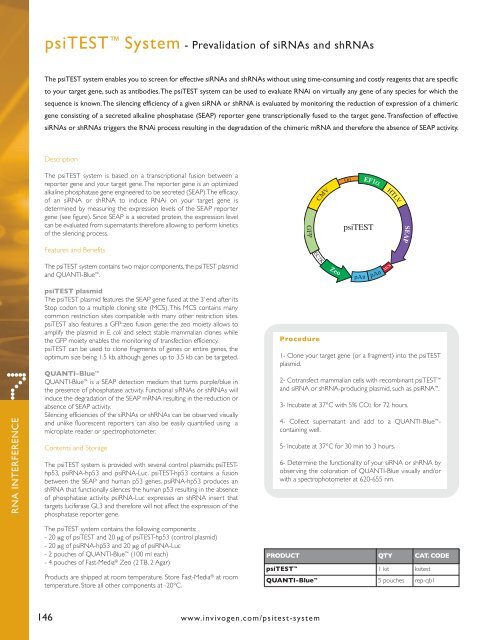scaricalo in formato PDF - labogen srl
scaricalo in formato PDF - labogen srl
scaricalo in formato PDF - labogen srl
You also want an ePaper? Increase the reach of your titles
YUMPU automatically turns print PDFs into web optimized ePapers that Google loves.
RNA INTERFERENCE 7<br />
psiTEST System - Prevalidation of siRNAs and shRNAs<br />
The psiTEST system enables you to screen for effective siRNAs and shRNAs without us<strong>in</strong>g time-consum<strong>in</strong>g and costly reagents that are specific<br />
to your target gene, such as antibodies. The psiTEST system can be used to evaluate RNAi on virtually any gene of any species for which the<br />
sequence is known. The silenc<strong>in</strong>g efficiency of a given siRNA or shRNA is evaluated by monitor<strong>in</strong>g the reduction of expression of a chimeric<br />
gene consist<strong>in</strong>g of a secreted alkal<strong>in</strong>e phosphatase (SEAP) reporter gene transcriptionally fused to the target gene. Transfection of effective<br />
siRNAs or shRNAs triggers the RNAi process result<strong>in</strong>g <strong>in</strong> the degradation of the chimeric mRNA and therefore the absence of SEAP activity.<br />
Description<br />
The psiTEST system is based on a transcriptional fusion between a<br />
reporter gene and your target gene. The reporter gene is an optimized<br />
alkal<strong>in</strong>e phosphatase gene eng<strong>in</strong>eered to be secreted (SEAP). The efficacy<br />
of an siRNA or shRNA to <strong>in</strong>duce RNAi on your target gene is<br />
determ<strong>in</strong>ed by measur<strong>in</strong>g the expression levels of the SEAP reporter<br />
gene (see figure). S<strong>in</strong>ce SEAP is a secreted prote<strong>in</strong>, the expression level<br />
can be evaluated from supernatants therefore allow<strong>in</strong>g to perform k<strong>in</strong>etics<br />
of the silenc<strong>in</strong>g process.<br />
Features and Benefits<br />
The psiTEST system conta<strong>in</strong>s two major components, the psiTEST plasmid<br />
and QUANTI-Blue .<br />
psiTEST plasmid<br />
The psiTEST plasmid features the SEAP gene fused at the 3’ end after its<br />
Stop codon to a multiple clon<strong>in</strong>g site (MCS). This MCS conta<strong>in</strong>s many<br />
common restriction sites compatible with many other restriction sites.<br />
psiTEST also features a GFP::zeo fusion gene: the zeo moiety allows to<br />
amplify the plasmid <strong>in</strong> E. coli and select stable mammalian clones while<br />
the GFP moiety enables the monitor<strong>in</strong>g of transfection efficiency.<br />
psiTEST can be used to clone fragments of genes or entire genes, the<br />
optimum size be<strong>in</strong>g 1.5 kb, although genes up to 3.5 kb can be targeted.<br />
QUANTI-Blue <br />
QUANTI-Blue is a SEAP detection medium that turns purple/blue <strong>in</strong><br />
the presence of phosphatase activity. Functional siRNAs or shRNAs will<br />
<strong>in</strong>duce the degradation of the SEAP mRNA result<strong>in</strong>g <strong>in</strong> the reduction or<br />
absence of SEAP activity.<br />
Silenc<strong>in</strong>g efficiencies of the siRNAs or shRNAs can be observed visually<br />
and unlike fluorescent reporters can also be easily quantified us<strong>in</strong>g a<br />
microplate reader or spectrophotometer.<br />
Contents and Storage<br />
The psiTEST system is provided with several control plasmids: psiTESThp53,<br />
psiRNA-hp53 and psiRNA-Luc. psiTEST-hp53 conta<strong>in</strong>s a fusion<br />
between the SEAP and human p53 genes. psiRNA-hp53 produces an<br />
shRNA that functionally silences the human p53 result<strong>in</strong>g <strong>in</strong> the absence<br />
of phosphatase activity. psiRNA-Luc expresses an shRNA <strong>in</strong>sert that<br />
targets luciferase GL3 and therefore will not affect the expression of the<br />
phosphatase reporter gene.<br />
The psiTEST system conta<strong>in</strong>s the follow<strong>in</strong>g components:<br />
- 20 μg of psiTEST and 20 μg of psiTEST-hp53 (control plasmid)<br />
- 20 μg of psiRNA-hp53 and 20 μg of psiRNA-Luc<br />
- 2 pouches of QUANTI-Blue (100 ml each)<br />
- 4 pouches of Fast-Media ® Zeo (2 TB, 2 Agar)<br />
Products are shipped at room temperature. Store Fast-Media ® at room<br />
temperature. Store all other components at -20°C.<br />
Procedure<br />
146 www.<strong>in</strong>vivogen.com/psitest-system<br />
1- Clone your target gene (or a fragment) <strong>in</strong>to the psiTEST<br />
plasmid.<br />
2- Cotransfect mammalian cells with recomb<strong>in</strong>ant psiTEST <br />
and siRNA or shRNA-produc<strong>in</strong>g plasmid, such as psiRNA .<br />
3- Incubate at 37°C with 5% CO2 for 72 hours.<br />
4- Collect supernatant and add to a QUANTI-Blue -<br />
conta<strong>in</strong><strong>in</strong>g well.<br />
5- Incubate at 37°C for 30 m<strong>in</strong> to 3 hours.<br />
6- Determ<strong>in</strong>e the functionality of your siRNA or shRNA by<br />
observ<strong>in</strong>g the coloration of QUANTI-Blue visually and/or<br />
with a spectrophotometer at 620-655 nm.<br />
PRODUCT QTY CAT. CODE<br />
psiTEST 1 kit ksitest<br />
QUANTI-Blue 5 pouches rep-qb1


